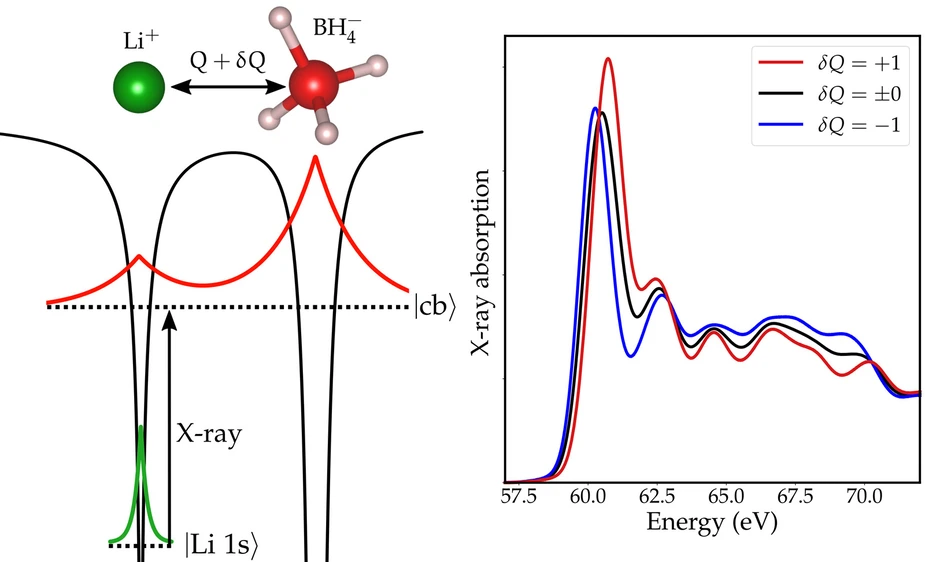The view into the crystal
MBI scientists recorded ultrasmall atom motions with ultrashort x-ray pulses
Periodic motions of atoms over a length of a billionth of a millionth of a meter (10-15 m) are mapped by ultrashort x-ray pulses. In a novel type of experiment, regularly arranged atoms in a crystal are set into vibration by a laser pulse and a sequence of snapshots is generated via changes of x-ray absorption.
A crystal represents a regular and periodic spatial arrangement of atoms or ions which is held together by forces between their electrons. The atomic nuclei in this array can undergo different types of oscillations around their equilibrium positions, the so-called lattice vibrations or phonons. The spatial elongation of nuclei in a vibration is much smaller than the distance between atoms, the latter being determined by the distribution of electrons. Nevertheless, the vibrational motions act back on the electrons, modulate their spatial distribution and change the electric and optical properties of the crystal on a time scale which is shorter than 1 ps (10-12 s). To understand these effects and exploit them for novel, e.g., acoustooptical, devices, one needs to image the delicate interplay of nuclear and electronic motions on a time scale much shorter than 1 ps.
In a recent Rapid Communication in Physical Review B, researchers from the Max Born Institute in Berlin (Germany), the Swiss Federal Laboratories for Materials Science and Technology in Dübendorf (Switzerland), and the National Institute of Standards and Technology, Gaithersburg (USA) apply a novel method of optical pump - soft x-ray probe spectroscopy for generating coherent atomic vibrations in small LiBH4 crystals, and reading them out via changes of x-ray absorption. In their experiments, an optical pump pulse centered at 800 nm excites via impulsive Raman scattering a coherent optical phonon with Ag symmetry [movie]. The atomic motions change the distances between the Li+ und (BH4)- ions. The change in distance modulates the electron distribution in the crystal and, thus, the x-ray absorption spectrum of the Li+ ions. In this way, the atomic motions a mapped into a modulation of soft x-ray absorption on the so-called Li K-edge around 60 eV. Ultrashort x-ray pulses measure the x-ray absorption change at different times. From this series of snapshots the atomic motions are reconstructed.
This novel experimental scheme is highly sensitive and allows for the first time to kick off and detect extremely small amplitudes of atomic vibrations. In our case, the Li+ ions move over a distance of only 3 femtometers = 3 x 10-15 m which is comparable to the diameter of the Li+ nucleus and 100000 times smaller than a distance between the ions in the crystal. The experimental observations are in excellent agreement with in-depth theoretical calculations of transient x-ray absorption. This new type of optical pump-soft x-ray probe spectroscopy on a femtosecond time scale holds strong potential for measuring and understanding the interplay of nuclear and electronic motions in liquid and solid matter, a major prerequisite for theoretical simulations and applications in technology.
Movie: What happens in the unit cell of crystalline LiBH4 after impulsive Raman excitation with a femtosecond laser pulse? Upper panel: measured transient absorption change Δ A(t) (symbols) as we vary the time delay between infrared pump pulses and soft x-ray probe pulses at photon energy of ħω = 61.5 eV [cf. Fig. 3(a) in the main article. The lower box shows the atoms in the unit cell of LiBH4 with red boron atoms, gray hydrogen atoms, and green Li atoms. The moving blue circle in the upper panel is synchronized with the moving atoms in the lower panel. The amplitude of the motion is strongly exaggerated (i.e. times 30000) to visualize the pattern of the motion. The reddish color of the unit cell indicates the intensity of the infrared pump pulse.
Original publication: Physical Review B 95, 081101 (R) (2017)
Ultrafast modulation of electronic structure by coherent phonon excitations
J. Weisshaupt, A. Rouzée, M. Woerner, M. J. J. Vrakking, T. Elsaesser, E. L. Shirley, and A. Borgschulte
Contact
Max Born Institute for Nonlinear Optics and Short Pulse Spectroscopy (MBI)
Max-Born-Straße 2A, 12489 Berlin
Dr. Michael Wörner
Tel. 030 6392 1470
woerner(at)mbi-berlin.de
Jannick Weisshaupt
Tel. 030 6392 1471
weisshau(at)mbi-berlin.de
Dr. Arnaud Rouzée
Tel. 030 6392 1240
rouzee(at)mbi-berlin.de
Prof. Dr. Marc Vrakking
Tel. 030 6392 1200
marc.vrakking(at)mbi-berlin.de
Prof. Dr. Thomas Elsässer
Tel. 030 6392 1400
elsaesser(at)mbi-berlin.de
